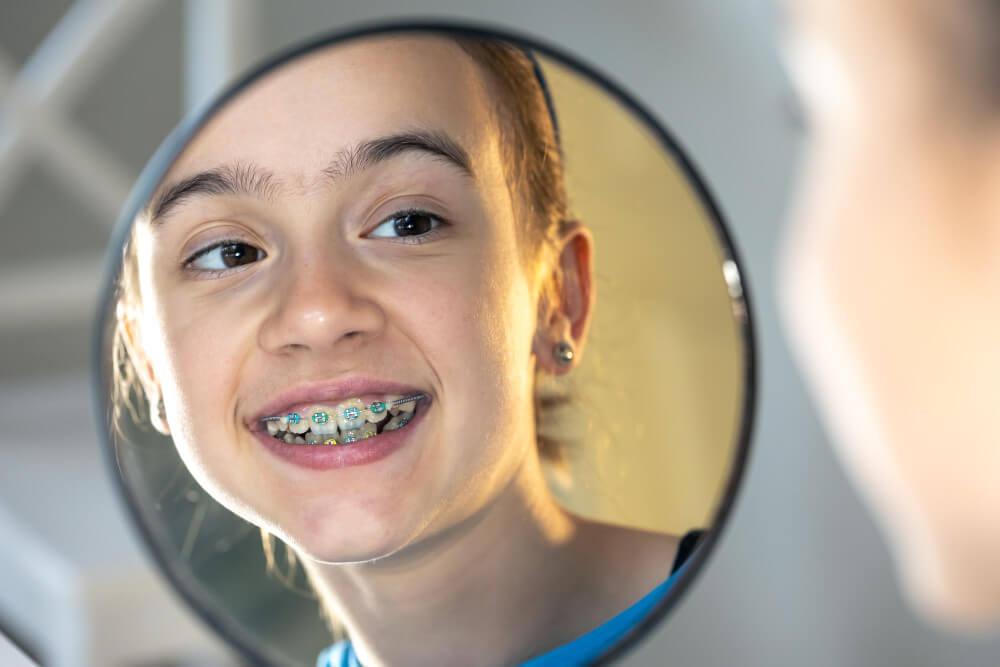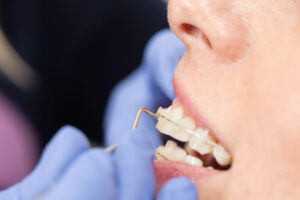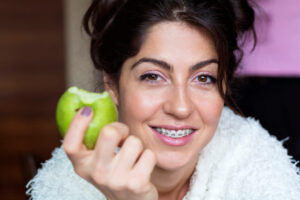Ultimate Guide to Dental Braces: Types, Care, and Achieving a Perfect Smile

Key Takeaways
- Purpose of Braces: Braces are orthodontic treatments aimed at aligning teeth and improving bite for aesthetic and health reasons.
- Indications for Braces: Crooked teeth, noticeable gaps, bite issues, discomfort while chewing, and speech difficulties are signs that braces may be necessary.
- Benefits Beyond Appearance: Braces not only enhance smile aesthetics but also improve oral health, digestion, and may alleviate jaw pain.
- Types of Braces: Traditional metal braces, ceramic braces, self-ligating braces, lingual braces, and clear aligners offer different levels of visibility and effectiveness.
- Treatment Duration: Treatment time varies based on factors like severity of misalignment, age, type of braces, and patient cooperation.
- Retention Phase: Wearing a retainer post-braces is crucial to maintain the results achieved.
- Side Effects: Discomfort, irritation, difficulty eating, speech changes, and increased saliva production are common side effects of braces.
Table of Contents
What Are Braces?
Braces are a specialized orthodontic treatment designed to create a beautiful, healthy smile. They are used to realign teeth and improve how your upper and lower jaws fit together (your bite).
This correction benefits not only the appearance of your teeth but also your overall oral health. Braces can boost your confidence, make it easier to chew properly, and even improve speech in some cases.
Do You Need Braces? Signs to Watch For
While crooked teeth are the most obvious clue, there are many other signals that your smile could benefit from orthodontic treatment:
- Visible issues: Overcrowded teeth, noticeable gaps between teeth, and significant bite problems (like overbites, underbites, or crossbites) are often prime reasons for braces.
- Subtle signs: Do you struggle to chew your food properly, or find yourself biting your cheeks or tongue often? These can be caused by misaligned teeth.
- Lingering discomfort: Jaw pain, clicking sounds when you open your mouth, or even recurring headaches can sometimes be related to alignment issues in your bite.
- Speech concerns: While less common, some forms of tooth misalignment can affect how you pronounce words, leading to lisping or other slight speech difficulties.
Why Getting Braces is More Than Just Cosmetic
Getting braces isn’t just about fixing a crooked smile – they offer a range of benefits for your overall well-being:
- Healthier teeth and gums: When teeth are aligned, cleaning them thoroughly becomes much easier. Crooked teeth create hiding places for plaque and bacteria, putting you at higher risk for gum disease and tooth decay.
- Confidence boost: There’s no underestimating the power of a smile you love. Braces can improve your smile’s appearance and, in turn, improve your self-image.
- Better digestion: Proper chewing is essential. Misaligned teeth can make this difficult, but braces can help you break down food properly for smooth digestion.
- Potential pain relief: In some cases, braces can relieve headaches and jaw pain caused by the way your bite forces your jaw muscles to work.
Types of braces
Traditional Metal Braces
The time-tested orthodontic workhorse! They consist of small metal brackets bonded to the front of your teeth, connected by a metal archwire held in place with small rubber bands (often customizable with colorful options).
- Pros: Most cost-effective solution, highly effective for a wide range of orthodontic issues, and the colored bands can be a form of self-expression for younger patients.
- Cons: Most visually noticeable type, can be slightly more challenging to keep clean around the brackets.
Ceramic Braces
Function just like traditional metal braces, but they trade metal brackets for tooth-colored or clear ceramic ones.
- Pros: Significantly less noticeable, offering a great balance of aesthetics and effectiveness.
- Cons: Slightly pricier than metal braces and the ceramic material can be prone to staining if oral hygiene isn’t meticulous.
Self-Ligating Braces
Instead of rubber bands, they use a built-in clip mechanism within the brackets to secure the archwire. They can be metal or ceramic for aesthetic options. The most known brand is Damon braces.
- Pros: May result in fewer office visits due to easier adjustments, potentially shorter treatment times in some cases, and the lack of rubber bands can make them easier to clean.
- Cons: Slightly higher cost compared to traditional metal braces.
Lingual Braces
The ‘hidden’ braces option! They work on the same principles as traditional braces but are completely customized and attached to the back surfaces of your teeth.
- Pros: Excellent for those prioritizing maximum discretion since they’re virtually invisible.
- Cons: Most expensive option, can take longer to adjust to due to their placement (sometimes impacting speech initially), and treatment length may be slightly increased.
Clear Aligners (like Invisalign)
This system uses custom-made, clear plastic trays that fit snugly over your teeth, applying gentle pressure to shift them over time. You progress through a series of trays designed to achieve your desired results.
- Pros: The most discreet option, removable for eating, brushing, and special occasions. They also come with fewer food restrictions.
- Cons: Significantly more expensive, effectiveness depends heavily on patient compliance (must be worn as instructed), and they aren’t suitable for complex orthodontic cases.
How Long Do Braces Take to Work?
The length of time braces take to work depends on several factors. Here’s a breakdown of what influences treatment time and expectations:
Factors Affecting Treatment Time
- Severity of Misalignment: The more complex the misalignment of your teeth or bite problems (overbite, underbite, crossbite), the longer treatment generally takes.
- Age: Younger patients often respond to orthodontic treatment faster since their jawbones are still developing. Adult treatment can still be incredibly successful but may take a bit longer.
- Type of Braces: Certain types, like self-ligating braces or aligners, can sometimes lead to slightly shorter treatment times in some cases.
- Patient Cooperation: Following your orthodontist’s instructions regarding care, wearing rubber bands (if needed), and attending appointments as scheduled are key to ensuring optimal progress.
Time Ranges
- Mild Cases: Simple crowding or spacing problems can sometimes be corrected within 6 to 18 months.
- Average Cases: Most people wear braces between 18 and 24 months.
- Complex Cases: Severe misalignments or significant bite issues might require treatment for 24 to 36 months or slightly longer in rare situations.
These are general ranges. Your orthodontist is the best person to give you a personalized estimate for your unique orthodontic needs.
Beyond Braces: The Retention Phase
Remember that your orthodontic journey doesn’t end the day your braces come off. You’ll need to wear a retainer as directed by your orthodontist to maintain your newly straightened smile. This prevents teeth from gradually shifting back towards their original positions.
What Are the Benefits of Dental Braces?
The Power of a Confident Smile
- More than just straight teeth: Braces go beyond simply aligning teeth – they can transform your facial proportions and overall appearance, influencing how you see yourself.
- Unlock Inner Confidence: An attractive smile can boost your interactions with the world, promoting positive self-image. This confidence can have ripple effects in social settings, job interviews, and interpersonal relationships.
Oral Health Advantages that Last
- A Healthy Mouth for Life: Straighter teeth aren’t just easier to clean, they also place less uneven stress on gums and supporting bone structures. This promotes long-term periodontal health, which is linked to overall well-being.
- Investing in Prevention: While braces require commitment in the short term, they set you up for a reduced risk of serious and costly dental work in the future. Think of orthodontic treatment as proactive care.
Functionality Beyond a Pretty Smile
- The Importance of a Proper Bite: A properly aligned bite helps you chew effectively, leading to improved digestion and better nutrition absorption.
- Beyond Speech Therapy: While not always a primary benefit, severe orthodontic cases can interfere with speech. Braces can help address issues like lisps or difficulty pronouncing specific sounds.
- Relief for Aching Jaws: Headaches, TMJ (jaw joint) pain, and clicking sounds can often be traced back to a misaligned bite. Braces can offer significant relief for those suffering from these issues.
Durability and a Lasting Investment
- Built to Last: Our teeth and jawbones naturally shift over our lifetime. Straightening them properly, as braces do, lays the groundwork for a healthy and resilient smile for years to come.
- Reduced Risk of Future Damage: Overcrowding, improperly aligned teeth, and bite issues increase the likelihood of uneven wear, chipped teeth, and further dental complications as you age. Braces help mitigate these risks.
What Are the Normal Side Effects of Braces?
While braces are generally safe, they can cause some side effects, which typically occur shortly after the braces are placed and may continue throughout the treatment period. Here are some normal side effects of braces:
- Discomfort or Pain: It’s normal to experience some discomfort or soreness after the braces are first placed and after adjustments. This discomfort usually subsides within a few days as your mouth adjusts to the braces.
- Irritation: The metal brackets and wires of braces may irritate the cheeks, lips, and tongue, causing sores or ulcers. Using orthodontic wax to cover any sharp edges can help alleviate this irritation.
- Difficulty Eating: Initially, you may find it challenging to eat certain foods or to chew properly as your mouth adjusts to the braces. Stick to softer foods and cut solid foods into smaller pieces if necessary.
- Speech Changes: You may notice changes in your speech patterns, such as difficulty pronouncing certain words or sounds. This is usually temporary and improves as you become accustomed to wearing braces.
- Loose Teeth: It’s common for your teeth to feel slightly loose as they gradually shift into their new positions. This is a normal part of the orthodontic process and should not cause concern.
- Gum Irritation: Braces can sometimes irritate the gums, leading to minor inflammation or swelling. Proper oral hygiene, including regular brushing and flossing, can help prevent gum irritation.
- Temporary Changes in Saliva Production: Some people may experience increased saliva production initially, which can be a temporary side effect of wearing braces. This typically diminishes over time.
- Difficulty Cleaning Teeth: Braces can make it more challenging to clean your teeth thoroughly, leading to an increased risk of plaque buildup and tooth decay. It’s essential to maintain excellent oral hygiene habits and use special orthodontic tools, such as interdental brushes or floss threaders, to clean around the brackets and wires.
FAQ on Dental Braces
Do Braces Hurt?
Braces may cause discomfort or soreness initially and after adjustments, but this typically subsides within a few days. Some people may also experience irritation from the metal brackets and wires. However, severe pain is uncommon, and any discomfort can usually be managed with over-the-counter pain relievers and orthodontic wax.
How Should I Care for My Braces?
To care for your braces, brush your teeth after every meal, floss daily, and use interdental brushes or floss threaders to clean around the brackets and wires. Avoid hard, sticky, or sugary foods that can damage the braces. Attend regular orthodontic appointments for adjustments and follow your orthodontist’s instructions closely. If you experience any issues or discomfort, contact your orthodontist for guidance.
How Can I Maintain My Results after Braces?
To maintain your results after braces, wear your retainer as directed by your orthodontist to prevent teeth from shifting. Avoid habits like nail-biting or chewing on hard objects that could damage your teeth or orthodontic appliances. If you notice any changes in your bite or tooth alignment, consult your orthodontist promptly.
Invisalign vs. braces: Which option is right for me?
Choosing between Invisalign and braces depends on your specific dental needs, lifestyle, and preferences. Invisalign offers a more discreet option with clear aligners that are removable, making it easier to eat and clean your teeth. However, braces are typically more effective for complex orthodontic issues.
Can I Buy Special Floss for Braces?
Yes, you can purchase special floss designed specifically for braces, known as orthodontic floss or floss threaders. These products typically have a stiff end or a built-in threader to help guide the floss under the wires of your braces, making it easier to clean between your teeth and around the brackets.
Can You Chew Gum with Braces?
Chewing gum with braces can be risky as it may get stuck in the brackets and wires, leading to discomfort and potentially causing damage. It’s best to avoid chewing gum while wearing braces to prevent these issues. If you have a strong urge to chew gum, consider sugar-free options that are less likely to stick to your braces.
Can You Be Allergic to Braces?
While it’s rare, some individuals may be allergic to certain components of braces, such as nickel or latex. Symptoms of an allergic reaction can include oral swelling, itching, redness, or blistering. If you experience any unusual symptoms after getting braces, consult your orthodontist, who can assess whether you have an allergy and recommend alternative materials if necessary.
Foods to Avoid With Braces
To protect your braces and prevent damage, avoid hard, sticky, or chewy foods such as hard candies, nuts, popcorn, chewing gum, and sticky candies like caramel. Refrain from biting into hard fruits like apples or corn on the cob. Cutting food into smaller, bite-sized pieces can help prevent damage to your braces and minimize the risk of breakage or dislodgment.
Resources
- Effectiveness of Self-Ligating Braces vs. Conventional Braces in Non-Extraction Treatment of Crowding: https://pubmed.ncbi.nlm.nih.gov/23299650/
- Clear Aligners vs. Conventional Braces in the Treatment of Malocclusion: A Retrospective Review: https://pubmed.ncbi.nlm.nih.gov/32221494/
- Management of Impacted Teeth by Orthodontic Treatment: https://www.wiley.com/en-sg/Orthodontic+Treatment+of+Impacted+Teeth%2C+3rd+Edition-p-9781444355710
- Orthodontic Considerations for Adult Patients: https://www.researchgate.net/publication/279523947_Adult_Orthodontics_Part_1_Special_Considerations_in_Treatment
- Early Orthodontic Treatment: A Review of Recent Evidence: https://pubmed.ncbi.nlm.nih.gov/17566300/
Fact Checked
Our dedicated team rigorously evaluates every article and guide to ensure the information is factual, up-to-date, and free of bias.
Updated Regularly
We update our articles and reviews regularly to ensure you have access to the latest data in the dental industry.
The content on Dental3DU’s blog is intended for educational purposes only. This information should not be relied upon as professional medical counsel. Be sure to always consult with your dentist about the dangers and benefits of any medication, treatment or procedure.







